The SB with M-103U and M-103A engines were characterized by a tunnel cooler located under the engines.
The planes produced in late 1939 had the air inlet controlled by a movable plate that could close completely the inlet, and introduced a landing light on the left wing leading edge; the pilot's mirrors were positioned on the sides of the sliding hood instead of the top of the windscreen.
planes produced in 1940 in the first half of 1940 introduced a fixed air inlet;
planes built in the second half of 1940 featured a recess under the cowling for the retractable ski landing gear.
All these planes could feature both the old-fashioned TUR-9 turret, both (more rarely) the ball MV-3 turret, that appeart to have ben refitted on many already built ones.
The SB with the improved M-104 engine were put in production in March-April 1940 at Factory n.22, namely Series 201. 53 planes were built; they were exteriorly undistinguishable from contemporaries SB 2M-103.
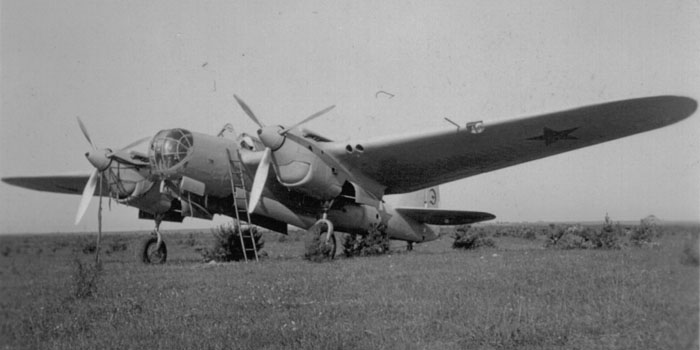
This SB 2M-103 A or U of 39th SBAP features the typical movable shutter on the cooler's intake, that appears completely closed on this image.
This grey plane is characterized by the red letter Eh instead of a number on its rudder, and it's probably the plane of the eskadilya commander. According to some profiles, it should have a very thin red border on the edge of its rudder. It features a landing light on the left wing leading edge.
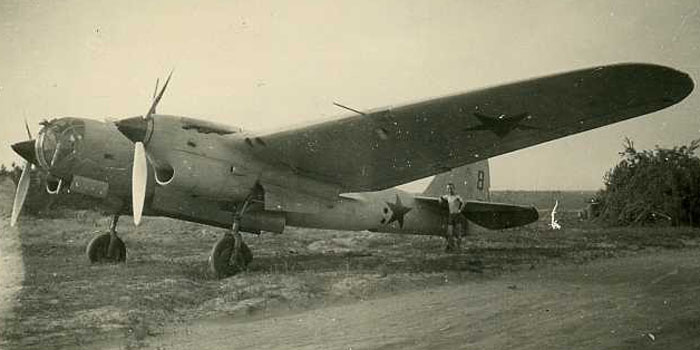
This plane, red (?) 8, shows the typical fixed inlet of the cooler, typical of planes built in 1940. The light grey finish reveals that it was buil before July 1940, when the green/light blue livery was introduced.
Note that the rudder hinges were covered by small plates for aerodinamic reasons; this allow to distinguish this variant by viewing the tail only.
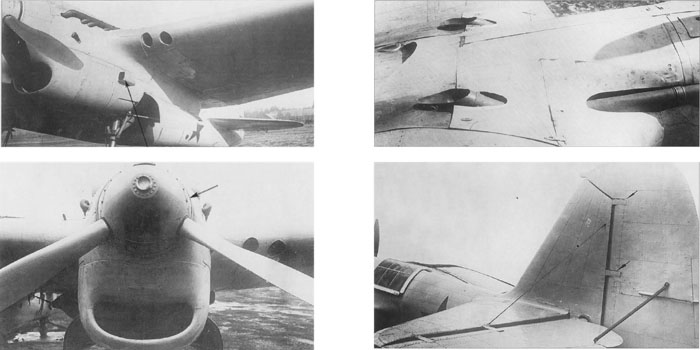
Some details of the SB n.1/221, the prototype of the version built in early 1940.
revised carburettor intake
fixed lips of the coolers intakes
deletion of the gap between spinner and engine fairing
improved exhaust stacks
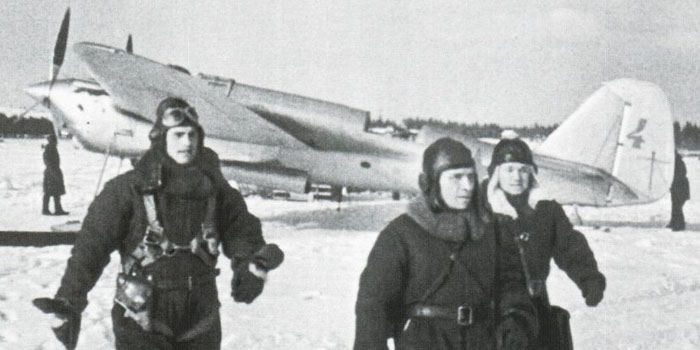
Red 4 features:
- the movable-shutter in the air inlets, typical of planes built in late 1939, in closed position;
- an apparently silver finish /(this could be due to the light conditions, because the silver finish was utilized on SB in 1938, much before the sharp-engined variant went into production)
- fixed ski landing gear.
On this photo, the way to paint in black part of the rear surface of the prop blades is very evident.

Anonymous SB M-103A. Being still painted with the early AE-9 light grey livery, it seems to conform to the standards of the first half of 1940: antenna mast on the windshield, fixed cooler intake lips, landing light on the left wing, ball-like MV-3 turret (probably refitted after the building, as suggested by the discontinuity of skinning visible on the profile of the back just in front of the turret.

SB 2M-103A black (or red with black shadowing) 9.
The tail has a (red?) cap and outline, after having been captured by Germans.
The irregularities in the skinning in front of the ball-like MV-3 turret suggest that this was refitted on a plane previously built with the earlier TUR-9 and sliding canopy.

This plane features a (black?) 3 on its rudder, and somehing strange, as an internal (yellow?) outline or other repainting, inside the black outline of the star on the fuselage.
On this image, the fact that the MV-3 turret is a refitting is more evident, because the rails of the sliding canopy are still there. Both the replacing of the skinning in front of the turret, bot the wider gap in comparison to other SB are evident.
The small plates covering the hinges of the rudder suggest that this plane is of 1940 production, with fixed coolers intakes.


An interesting color photo of the tail of a SB of 24th SBAP of 13-BAD. The number on the tail looks black. The color of the tip could seem as dark green.
This plane is represented as a SB-bis with TUR-9 turret under sliding canopy on a profile of Aviapark 2/2010. The plates covering the hinges of the rudder suggest that it was produced in the first half of 1940, and had fixed intake coolers.
image Militaria-fotos
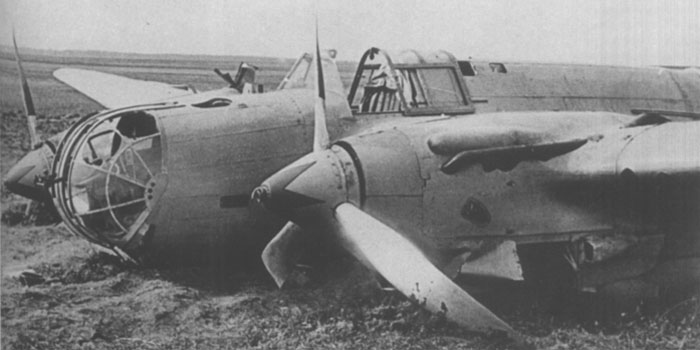
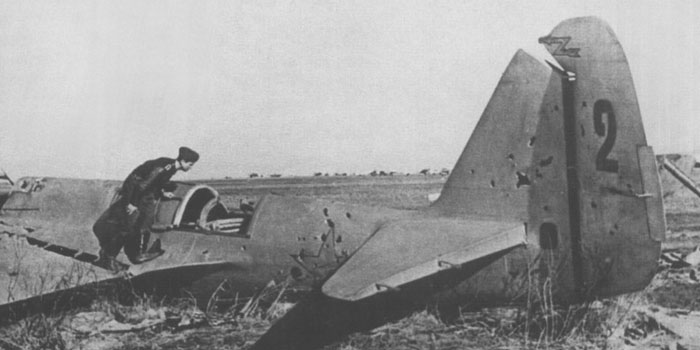
Two images of an interesting SB 'black 2' characterized by red stars with thin red outlines on the spinners and a (silver?) lightning with black outline on its rudder. The plane made an emergency landing just after the war outbreak.
The gap behind the spinner suggests a plane built in late 1939 with movable shutters on the intakes of the coolers.
Images from monografie Loctnicze n.083.

Images of two planes, blue 1 and blue 3, during the winter war. The planes look of early 1940 production with fixed lips and covered hinges of the rudder.
The planes (at least the n.1) have (blue?) recognition bands on the wings outside the engines, a blue/white cap with a small red star.
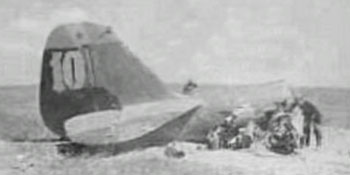 http://crimso.msk.ru/Site/Crafts/Craft20867.htm
http://crimso.msk.ru/Site/Crafts/Craft20867.htm
Right: on the left, a plane of the same unit but with the typical black/green camouflage utilized during the Great Patrioctic War, probably in summer 1941.
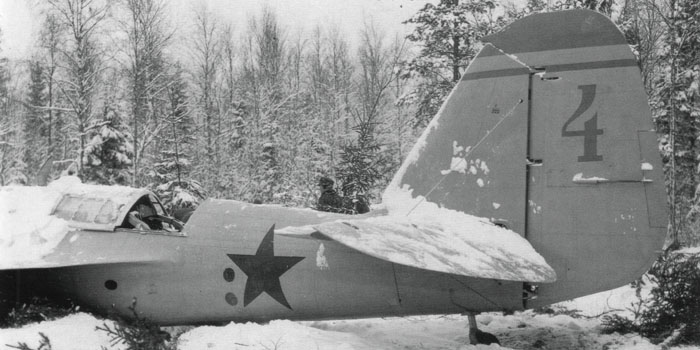
This SB of 8 BAP (24 SBP, according to other sources) was shot down by Finns on December 1, 1939. On the tail, one can read the number 11/220, that was the last series to be equipped with movable shutters on the coolers intake.

Interesting image showing two wrecked SB of the same unit.
The color of the cap. of the numbers and of the trim tabs is clearly lighter than the red of the stars; it could be some blue. The numbers are shadowed with a darker color that could be the same darkness of the red stars.
The number 10 is painted over a darker background (yellow?).
The visible slots for hinges on n.10 suggest a plane built in late 1939 with movable coolrs lips, while the rudder of n.2 suggests a plane built in early 1940 with fixed intakes.
From Tupolev SB of Maslov.
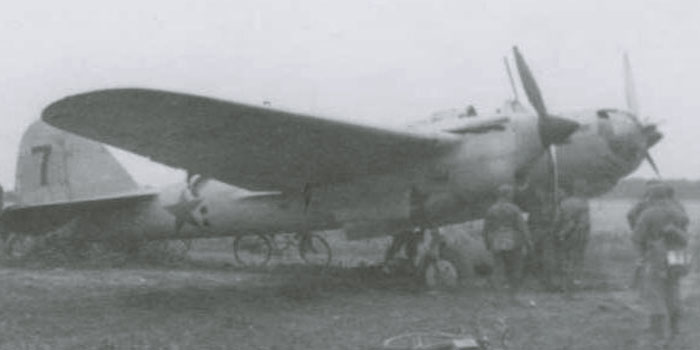
SB produced in the first half of 1941, with fixed air intakes, antenna mast and probably MV-3 turret. The livery is light grey overall, with apparently black spinners.
The use to mottle the light surface of SB, as well of I-153s and other types, started in summer1939 during the Khalkin-Gol war against Japaneses, when the planes of the 100th Aviation Brigade had green mottling or wavy lines painted on them. However, a very thin pattern of green lines seem visible even on a photo dated in winter 1938.
The use was extended to other units too, so, at the war outbreak, many SB showed green (and sometimes black) mottles or wavy lines over their original light livery.
 AII
green: gloss nitro paint introduced in 1938 and widely utilized on mixed
construction planes as I-16. It's usable over a primed metallic surface,
and is the most likely color for mottles.
AII
green: gloss nitro paint introduced in 1938 and widely utilized on mixed
construction planes as I-16. It's usable over a primed metallic surface,
and is the most likely color for mottles.
The oil paint AE-7 is supposed to be very similar.
 Early
olive green utilized before 1935 or 1937: possibly utilized for mottles.
Early
olive green utilized before 1935 or 1937: possibly utilized for mottles. 3B
dark green: oil paint utilized for army vehicles and, in unknown extent, on
metallic planes in 1935-37. Possibly utilized for mottles.
3B
dark green: oil paint utilized for army vehicles and, in unknown extent, on
metallic planes in 1935-37. Possibly utilized for mottles. Black:
possibly utilized for mottles and stripes aside greens.
Black:
possibly utilized for mottles and stripes aside greens. AE-9:
gloss light grey oil enamel, the common base color of SB.
AE-9:
gloss light grey oil enamel, the common base color of SB. AE-8
gloss aluminium old paint: believed to be utilized as a base color only on
some flat-engined SB built in 1938.
AE-8
gloss aluminium old paint: believed to be utilized as a base color only on
some flat-engined SB built in 1938.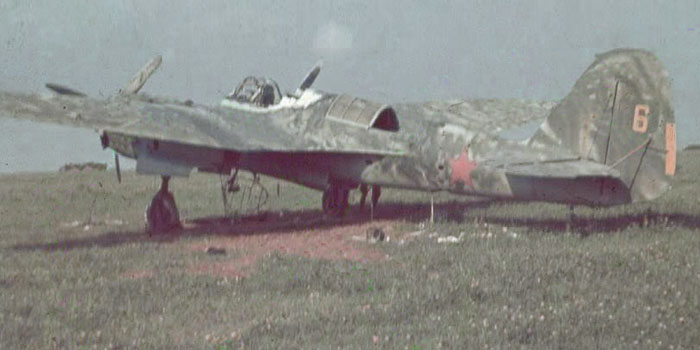
An exceptional color image shows the use of at least two shades of green to camouflage this plane over its light grey base.
The photo undoubtedly confirms the use of yellow for marks before the war outbreak. After the summer 1941, yellow was abandoned because Germans and their allies utilized it as an identification color.
This plane looks of early 1940 production, with fixed lips and covered hinges of the rudder.
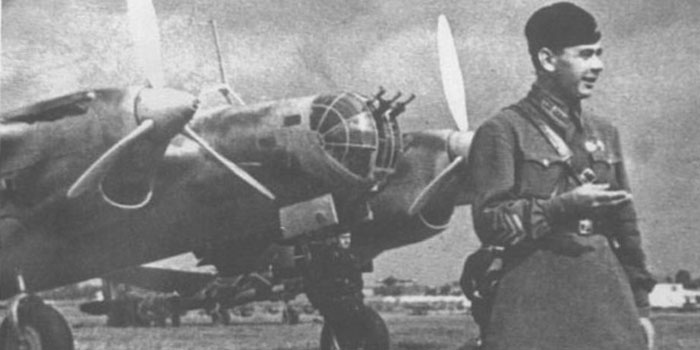
Image of a late production SB M-103A camouflaged with large green and black spots over the grey background before the war outbreak. The plane is provided with an antenna mast, and probably of ball-shaped MV-3 turret.
Image from Tupolev SB of Maslov.

This image of SB shows very well green and black dots, sprayed on light grey background on the sides of fuselage and engine nacelles. Probably upper surfaces were painted in the same way.
Image from Tupolev SB of Maslov.
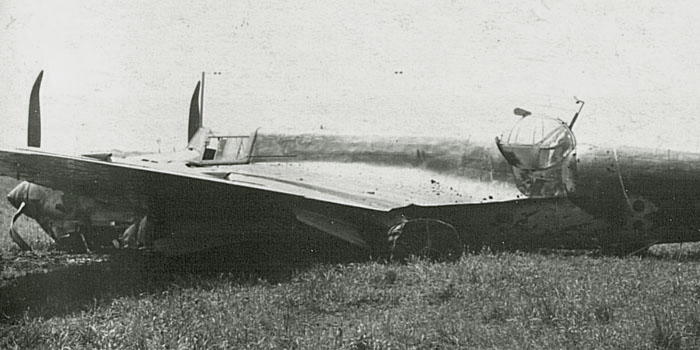

A beautifully camouflaged SB 2M-103A that made an emergency landing in Finland in 1942.
The camouflage, made on a light grey base, included both sprayed green dots and brush-painted black dotson the uppersurfaces, and thin black spaghetti on the side surfaces.
Note the antenna mast, suggesting that the plane likely had the ball-like MV-3 turret.
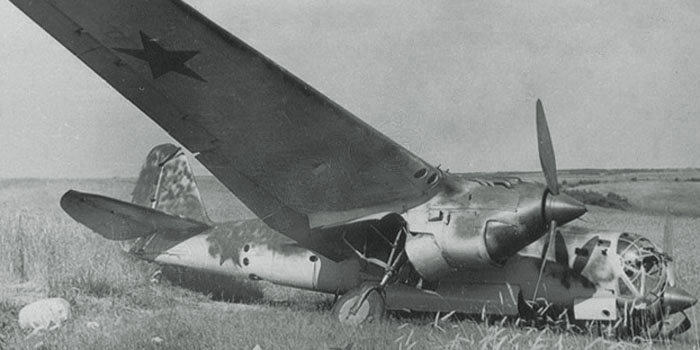

A SB 2M-103A 'red 8' of late 1939 production with dotted green painting on grey background.
Below: despite the strong similarity, this image taken in Kiev military district is from another plane with slightly different camouflage and AE-8 aluminium background, probably an SB with flat engines built in 1938. Note the red number 1 inside a green circle, and the small starlet with black outline on the rudder.
From Monografie Loctnitze n.083
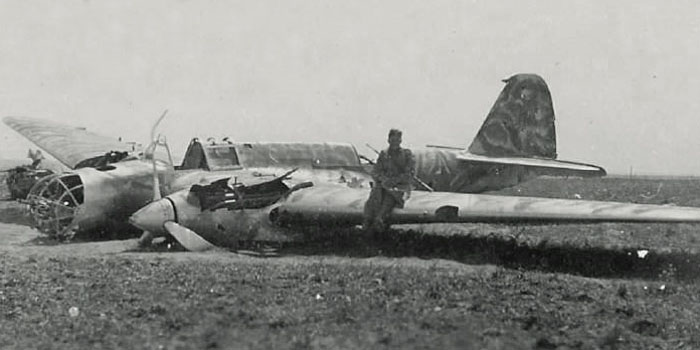
The combat planes built between June 1940 and July 1941 conformed to a new standard, with gloss green A-19f uppersurfaces and gloss light blue A-18f undersurfaces.
The existing planes had to be repainted in green on their uppersurfaces, leaving the undersurfaces of the previous color, AE-9 in the case of the sharp-engined SB. Only a part of the existing planes was subject to such repainting.
Often existing planes were left with their original light grey livery, sometimes mottled or striped with green and eventually black or other colors, as in use in some units since the wars against Japaneses.
The prop blades continued to be left unpainted on their front face, with the rear face partially painted black.
 A-19f
green: utilized for all the upper and side surfaces of all-metal planes as
the SB. It's believed that it was prone to a quick fading to a grass green,
although preserving the gloss finish.
A-19f
green: utilized for all the upper and side surfaces of all-metal planes as
the SB. It's believed that it was prone to a quick fading to a grass green,
although preserving the gloss finish.
 A-18F
light blue: color of the undersurfaces of all metal planes, as SB, built after
June 1940.
A-18F
light blue: color of the undersurfaces of all metal planes, as SB, built after
June 1940. AE-9
light grey: the color previously utilized for overall painting before June
1940 was preserved even on the undersurfaces of the planes, even if their
uppersurfaces were repainted in green.
AE-9
light grey: the color previously utilized for overall painting before June
1940 was preserved even on the undersurfaces of the planes, even if their
uppersurfaces were repainted in green. 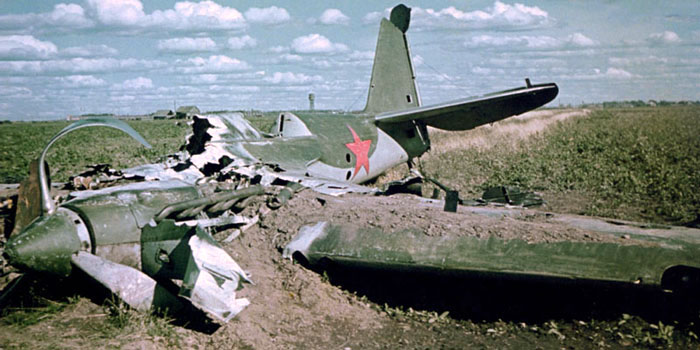
A rare color photo shows a SB M-103 A without turret, delivered with grey livery and repainted with A-19F green on upper and side surfaces. Brush strokes and an unusually curved demarcation line on the fuselage are visible.
The large gap behind the spinner suggests a plane built in late 1939 with movable shutters on the air intakes of the coolers.
However, large numbers of SB built before 1940 conserved their original livery (overall AE-9 grey) till the war outbreak, or some type of improvised spotty camouflage on this base.

SB 2M-103A n.1 built in 1940. This plane could have been painted in factory with the green/light blue livery.
The rear disk of both spinners looks pained red, while the front of the spinner could be green.
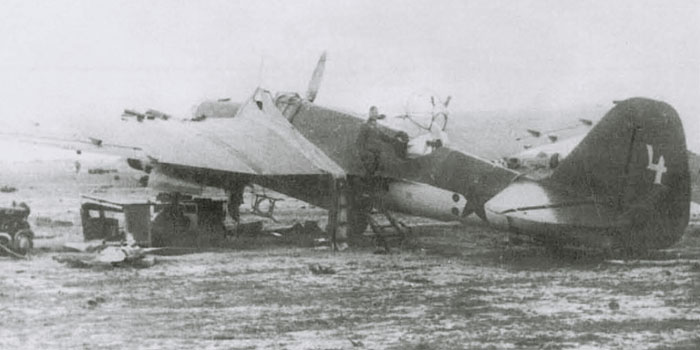
Late production SB 2M-103A captured by Germans in 1941. The plane features the aerial mast, the ball-like MV-3 turret (the ShKAS had been removed) and a strangely shaped '4' (yellow?) on its rudder.
From Tupolev SB of Maslov

Late production SB M-103A 'red 7' with a nice red starlet, outlined in white, on the rudder.
Note the radio mast and the clear protection for the ventral machine gun position, characteristic of late production SB.
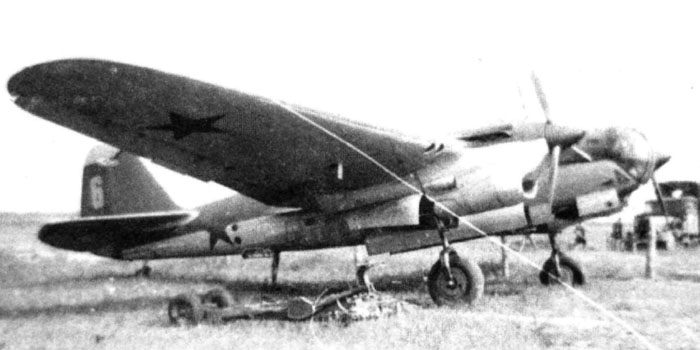
SB 2M-103 characterized by a (yellow?) 6 and a yellow cap on the rudder. The aerial mast and some opened windows at the ventral gunner's position are visible.
image from Airwar 06



Three interesting photos of a late SB M-103A with the green/light blue livery introduced in May 1940.
It features a silver 28 on its fuselage sides and a beautiful cat painted on its stabilizator, unknown if on one side or both; besides, there is a strange frame painted (in yellow?) on the upper of the rudder.
The antenna mast and the ball-like MV-3 turret (covered by a cloth) suggest a plane built in late 1940, with fixed coolres inlet.
(via Alexandr Ruchkowsky)
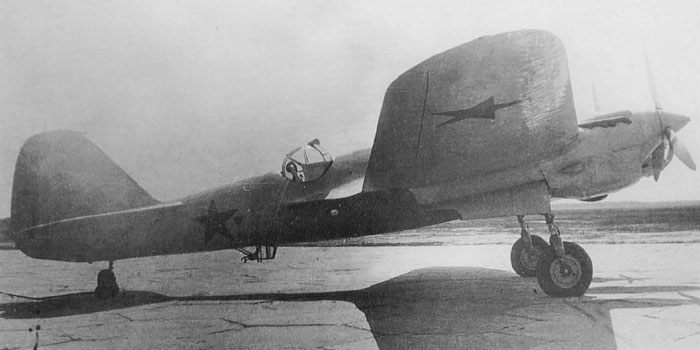
SB 2M-105 n.1/225 at the state tests at the NII VVS in spring 1940. The shape of engine cowling is sharper than usual.
The plane, painted in AE-9 light grey, features both the MV-3 ball turret and the glazed MV-2 ventral installation.
From Tupolev SB of Maslov
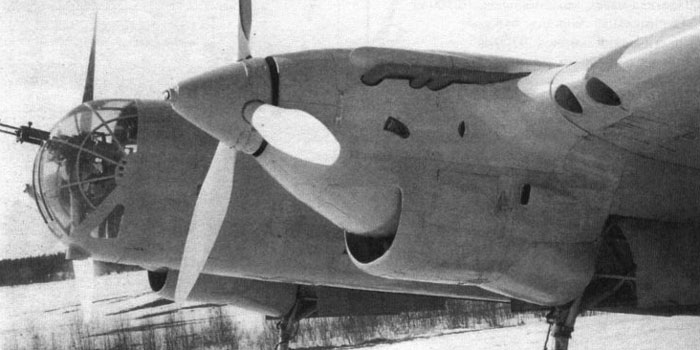
This SB (series 221) had a particularly sharp engine cowling, with movable shutter in more rearward position than later serie planes. This shape was rarely seen on production planes, the most of which seems to have preserved the less sharp shape of M-103 engined planes.
image from Modelist Konstruktor
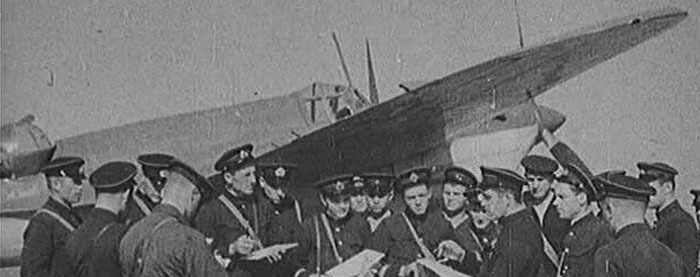
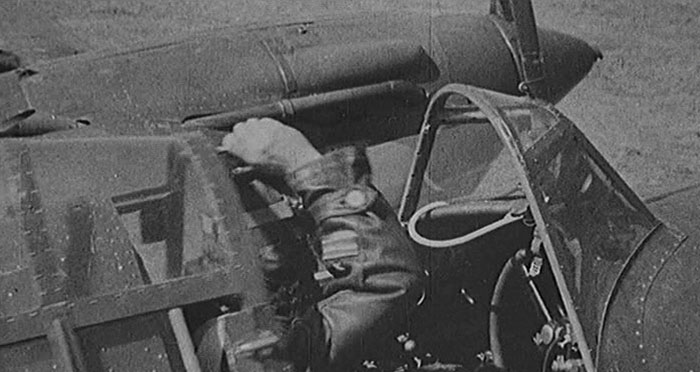
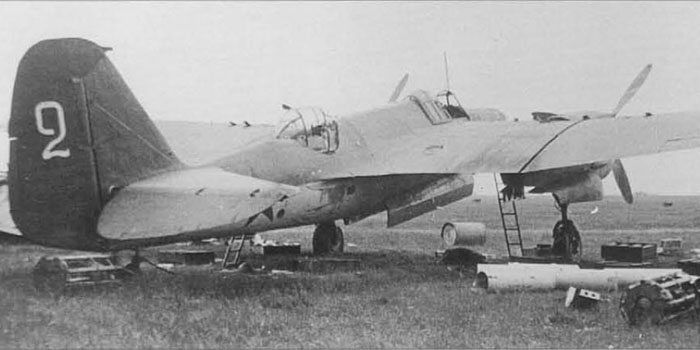
SB 2M-105 abandoned in summer 1941. The wooden containers on the ground are for FAB-100 bombs, while the light grey cylinders are for small bombs, to be mounted vertically inside the bomb bay.
One can distinguish the windshield divided in four clear panels with a frontal one (instead of being razor-shaped as previous variants).
From Tupolev SB of Orlov
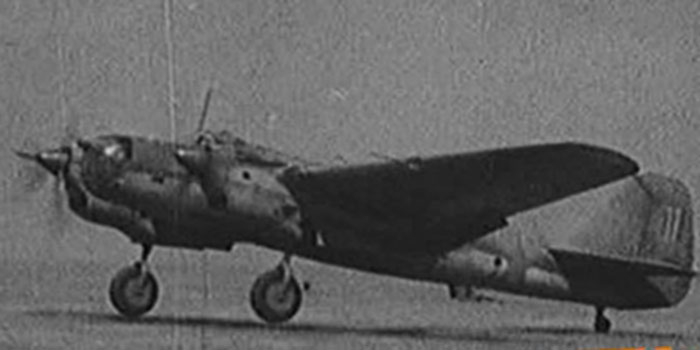
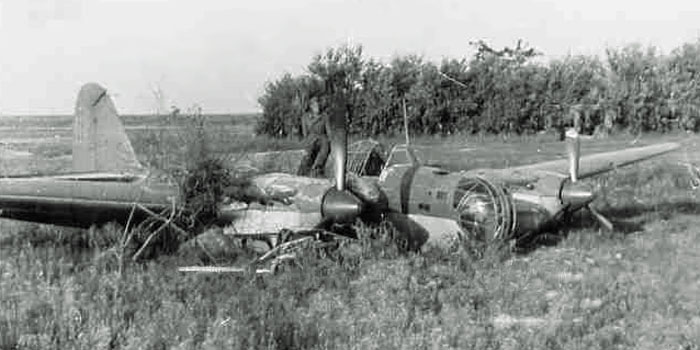
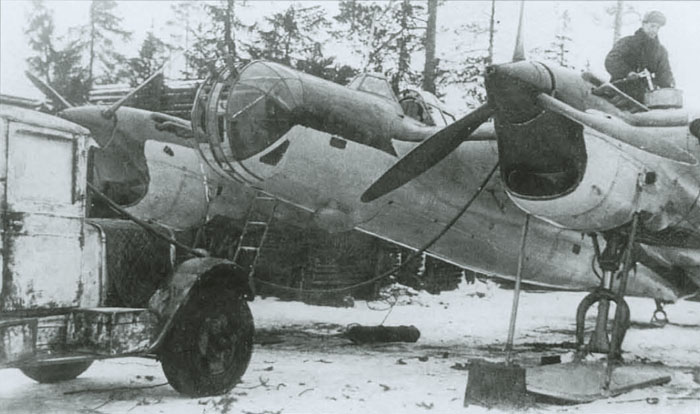
SB 2M-105 of 137th SBAP on the Nortern front in winter 1941/42.
The plane features black repaintings, evident on the engines but probably extended on a wide part of upper surfaces to fit the standard black-green camouflage introduced in 1941. Probably the red stars over the wings were obliterated, and new red stars were painted on the tail conforming to the use introduced at the war outbreak.
Note the retractable ski landing gear and the recesses for skis retraction behind the coolers outlet.
The antenna mast on the windshield is strangely painted with a light color.
From Tupolev SB of Maslov
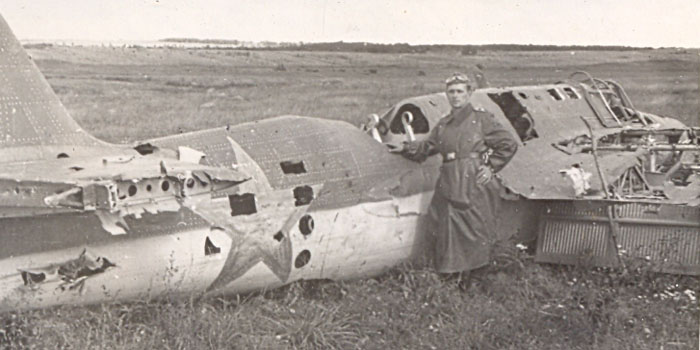
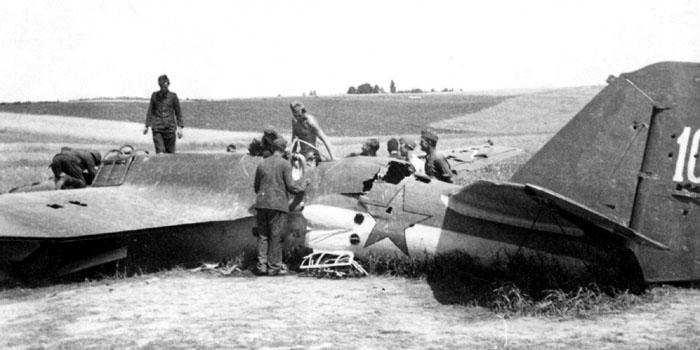
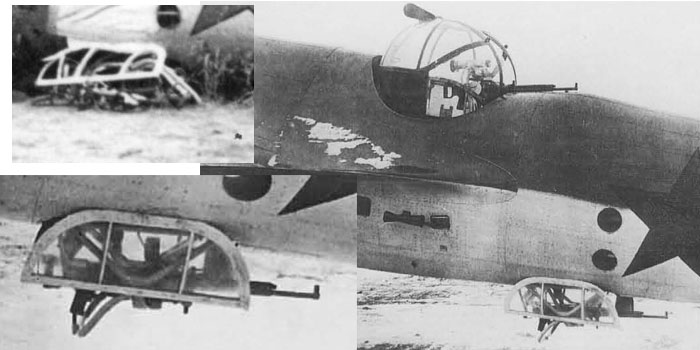
Some details of the last variant of MV-2 installation, similar to that of Ar-2. Note the unusual Venturi probe, never seen in that position on other photos of SB.
Images from Tupolev SB of Maslov, ed. Icarus
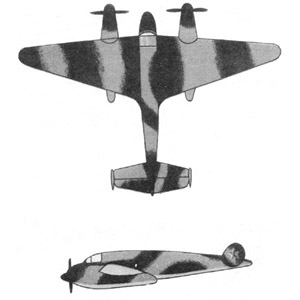 On
20 June 1941, the last day of peace, it was published an order of NKAP (the
Ministry for Aeronautical Industry) to paint all planes with a new standard
camouflage within one month.
On
20 June 1941, the last day of peace, it was published an order of NKAP (the
Ministry for Aeronautical Industry) to paint all planes with a new standard
camouflage within one month.
For newly built planes, the instructions said to utilize matt light blue for undersurfaces (not specified what type of paint, but all previous light blue paintings were gloss, so they have to be A-28m for all-metal planes and AMT-7 for mixed construction planes).
Apart for some Yaks, the first known photos of planes with the new green/black painting scheme are dated to July 13, 1941.
Many maintenance manuals of the first years of war describe these paints: dope AMT-4 green, AMT-6 black and AMT-7 blue enamel or oil A-24m, A-26m and A-28m of the same colours. Oil colors were less utilized, also because AMT colors can adhere well to primed metal surfaces.
Despite their name (M= matt), AMT colors were semigloss when new, and turned to matt finish with ageing. Occasionally, they could have been overpainted with a layer of gloss varnish AB-4-d to improve aerodinamicity and gain some speed.
While AMT-4 and 6 were codified in July 1941, AMT-7 was codified in August 1941, and is not mentioned on earlier manuals; earlier AII light blue remained in use in parallel with the darker AMT-7 in the first years of war.
Oil enamels were intended to be sprayed on the exterior metal surfaces, even unprimed. Painting with a brush meant poor paint properties, and was allowed only as a second choice, ex. for repairs.
Prop blades were now fully painted black.
The order of June 1941 changed the national marks of planes too. Red stars, of plan tipe or with thin black outline, were now placed in four or six positions:
- one on each side of fuselage (not always),
- one on each side of rudder/stabilizer,
- one on the undersurface of each wing (lower wing, in case of biplanes).
Note the deletion of stars over the wings, and the introduction of new ones on the tail.
The release of a clear directive on camouflaging the planes with green and black bands, with light blue undersurfaces, reached the units contemporarily with the war outbreak, when the frontline units had other things to worry about.
The directive previded that the existing planes, already painted with a layer of green on uppersurfaces (both AII green, A-19f or earlier types of protective), had to be painted with black bands, eventually preserving the original green and the original color of undersurfaces.
The red stars on the upper face of wings were usually obliterated with camo colors, and new stars were added on the sides of the tail in addition to those on the fuselage.
 A-19f
green: the standard gloss green for uppersurfaces between June 1940 and July
1941. Easily preserved as a base color after the war outbreak. It's believed
to be dark when new, and to fade quickly to a lighter shade preserving the
gloss finish for a relatively long time.
A-19f
green: the standard gloss green for uppersurfaces between June 1940 and July
1941. Easily preserved as a base color after the war outbreak. It's believed
to be dark when new, and to fade quickly to a lighter shade preserving the
gloss finish for a relatively long time. A-18f:
gloss light blue for undersurfaces between June 1940 and July 1941. Easily
preserved as color of the undersurfaces.
A-18f:
gloss light blue for undersurfaces between June 1940 and July 1941. Easily
preserved as color of the undersurfaces. AMT-4:
the standard matt green for new-built mixed construction planes. Possibly
utilized to repaint some SB.
AMT-4:
the standard matt green for new-built mixed construction planes. Possibly
utilized to repaint some SB. AE-9:
gloss light grey oil enamel, the common base color of SB till June 1940. Easily
preserved as color of the undersurfaces..
AE-9:
gloss light grey oil enamel, the common base color of SB till June 1940. Easily
preserved as color of the undersurfaces.. AMT-6:
the standard matt camouflage black, usable both aside AMT-4 and over A-19f
green to camouflage old planes. It was not 100% dark, particularly if utilized
in a thin layer or faded.
AMT-6:
the standard matt camouflage black, usable both aside AMT-4 and over A-19f
green to camouflage old planes. It was not 100% dark, particularly if utilized
in a thin layer or faded. AMT-7
matt light blue: standard for undersurfaces of newly-built planes after June
1941. Possibly utilized to repaint the undersurfaces of some old planes.
AMT-7
matt light blue: standard for undersurfaces of newly-built planes after June
1941. Possibly utilized to repaint the undersurfaces of some old planes. AMT-1
matt light brown: occasionally utilized in 1941-43 for non-standard camos,
became standard on non-fighter planes after the August 1943.
AMT-1
matt light brown: occasionally utilized in 1941-43 for non-standard camos,
became standard on non-fighter planes after the August 1943. AII
gloss light blue: standard color for new-built mixed-constructon planes (not
for all metal SB, then) between July 1940 and June 1941, also utilized after
that date as an alternative to AMT-7. Possibly utilized to repaint the undersurfaces
of some old planes.
AII
gloss light blue: standard color for new-built mixed-constructon planes (not
for all metal SB, then) between July 1940 and June 1941, also utilized after
that date as an alternative to AMT-7. Possibly utilized to repaint the undersurfaces
of some old planes.
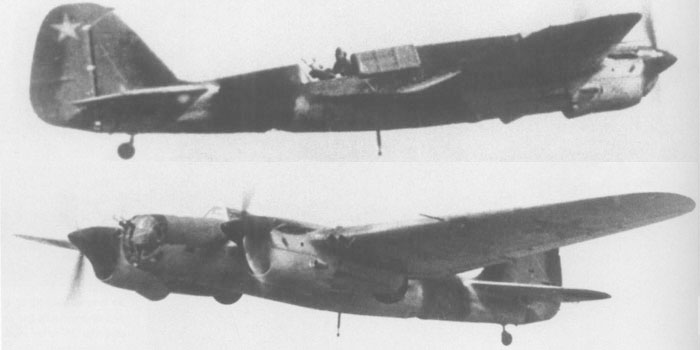
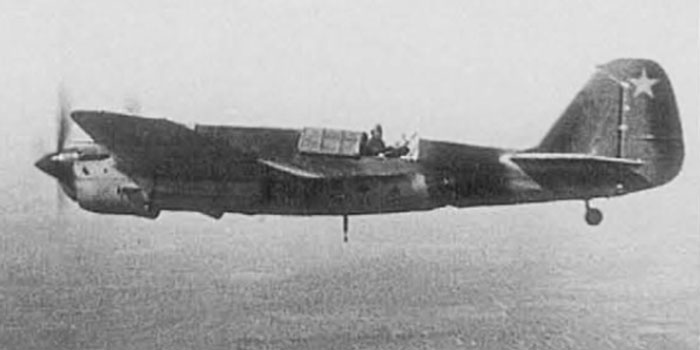

Other images of SB from a movie of before 1941. The plane of the small image on the upper left is not the same of the other images. They show two planes repainted with the camo inroduced in June 1941. The dorsal turret looks very strange, as an MV-3 deprived of its trasparent parts and of part of its metal sides too.
For what one can see, the camo pattern of the second plane resembles enough that of Pe-2, with black nose, engines, wingroots and band behind the gun position.
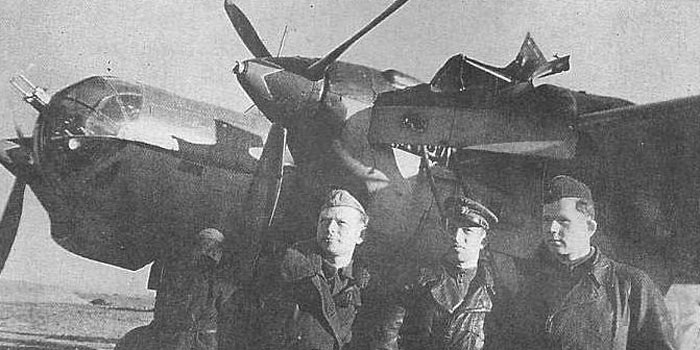
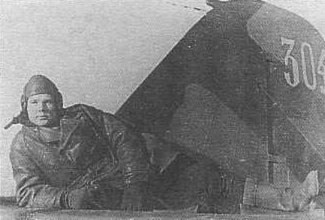 Two images
of plane n.304 of 367th BAP, Krimean front, 1942.
Two images
of plane n.304 of 367th BAP, Krimean front, 1942.
The plane looks a SB 2M-103A of late production, with fixed cooler intakes, radio mast and probably an MV-3 turret.
The original A-19f/A-18f green/blue livery has been modified with the addition of black bands made by brush, that obviously include both propellersand spinners and part of the tail, but not the nose.
The white-bordered red stars on the spinners, the small star on the rudder, the number 308 in a light color (perhaps light blue) with dark outline are interesting characteristics of this plane.
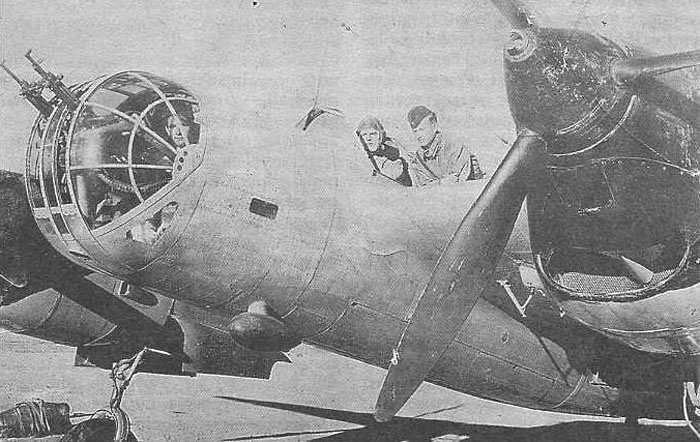
A SB M-103A of early 1940, photographed on the Crimean front in February 1942. .
The plane looks to have preserved its original light grey livery, with engines and propellers painted black.
Note the inside of coolers, the bomb racks and the drop-like fairing for the radio direction finder, moved on the left to prevent the navigator from hitting it while bailing out.

SB 2M-103A of the 1st Guards mine-laying-torpedo regiment of the Baltic fleet in 1943.
They are to be loaded with phosphorus-filled WAP containers.
The camouflage looks made by green, black and some very light color, perhaps the remains of a white winter dotting.


Left: Two images of a downed SB 2M-105 of 5th SBAP, apparently red 21. The plane has an accident in late fall of 1941.
The most surprising thing is that it looks made by joining pieces of many planes: the rear fuselage and tail looks light grey, while the other parts of the plane looks to have the green/light blue livery, possibly modified by some black camo bands. The shape of the windsheld is typical of SB 2 M-105, but the sliding hood looks straight, typical of earlier versions.
 Right: : the tail
of a wrecked SB of unknown version showing interesting camo and number (probably
blue with white outline).
Right: : the tail
of a wrecked SB of unknown version showing interesting camo and number (probably
blue with white outline).
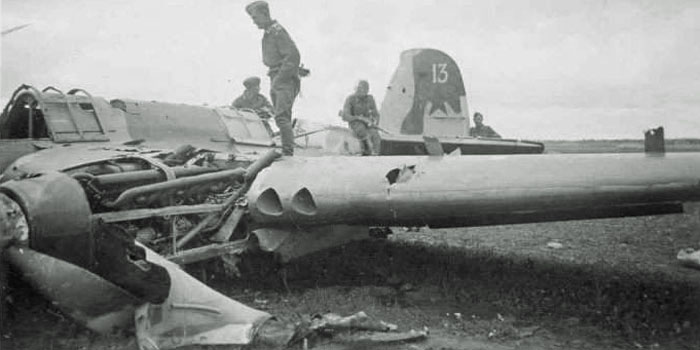
Interesting image of a SB M-103A with a polychromatic camouflage made with unknown colors. It resembles a lot to the camouflage utilized on an unit of Pe-2 at the war outbreak.
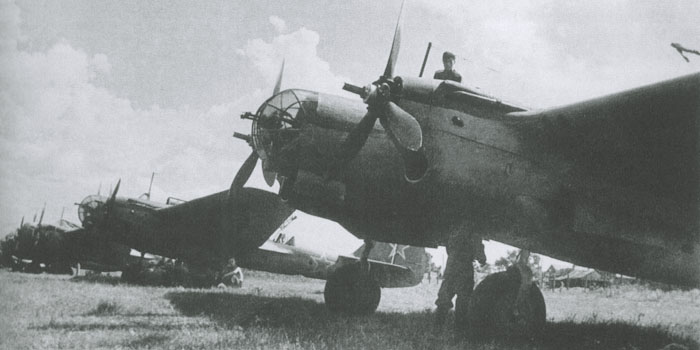
One of the last regiments equipped with SB took part in the victory air parade in August 1945.
The planes seem to have preserved the green-blue finish they had at the war outbreak, probably repainted with the equivalent AMT-4 and AMT-7 colors that were matt and darker than the original A-18f and A-19f. The red stars have the typical placing and white-red outlines that were usual in 1945.
(from Tupolev SB of Maslov)

A rare image of a SB in winter finish. The rear-moved coolers intakes with movable lips suggest a plane of early production, serie 221.
Note the non-standard position of the mast, clearly due to a refitting.
The plane looks numbered white 26. Note that the white finish assumes the look of a dotting on the left engine, while the right engine appar dark.
Image from Tupolev SB by Maslov